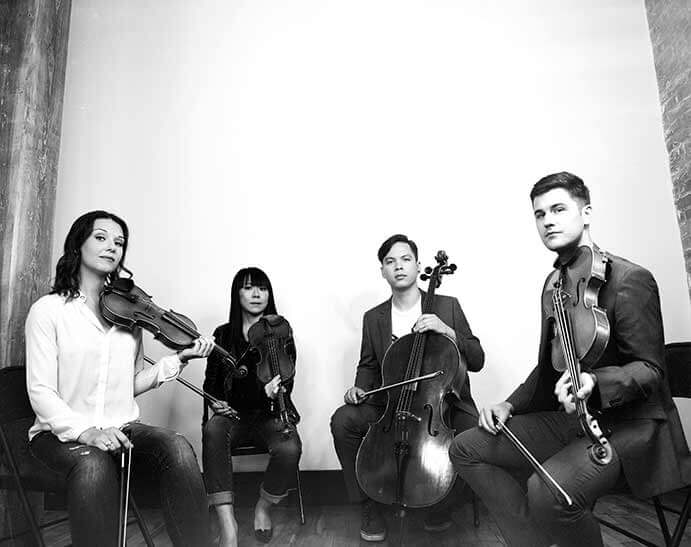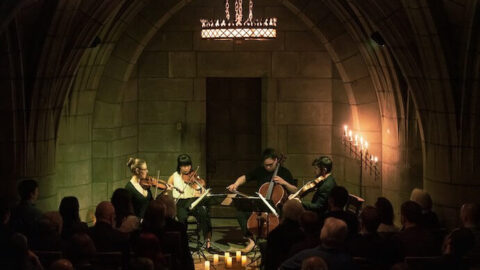A hip group of concertgoers dressed mostly in black met on a chilly spring evening at the border of Harlem and Washington Heights for the latest iteration of The Crypt Sessions, a classical music concert series presented by Unison Media and curated by Andrew Ousley. The award-winning series takes place in an actual crypt underneath the Church of the Intercession on West 155th Street. While there is certainly a nod to the macabre in the dimly illuminated space (complete with a dramatic candelabra on the makeshift stage), the Crypt is a surprisingly cozy venue sequestered away somewhere between the cemetery above and the subway tunnels beneath.
The April 30th installment of The Crypt Sessions featured Attacca Quartet playing an all-Caroline Shaw program of string quartets. If you missed the chance to hear the program at the Crypt, you can catch it all on the Attacca Quartet’s latest album Orange, which was released last month on New Amsterdam and Nonesuch Records.
Shaw’s music has a charismatic elasticity when it comes to genre and appeal. The winner of the Pulitzer Prize for Music in 2013, she has produced for Kanye West (The Life of Pablo; Ye) and worked with groups from The National to the LA Philharmonic. Attacca Quartet’s performances similarly rode the line between classical-infused and indie/pop aesthetics, and made for a deeply felt and intimate program. The acoustics of the Crypt seemed to be made for this music and instrumentation. The hard stone structure offered just the right amount of reverb and depth, and the dim lighting and atmosphere gave space for contemplation.

Shaw’s string quartets often capture the transfer of energies through a core material. A single chord progression or cadence may be stretched out for minutes at a time, but is constantly transformed by various currents charging through. At times, the music rushes forth with bristling arpeggios and flurries of pizzicati, and at other times, it slows to a cold freeze, where sustained pitches stretch out until they are rendered nearly inert.
In Entr’acte, Shaw takes raw cadential material as a motivic subject that runs throughout the piece. She does not shy away from revealing the building blocks at the heart of her music. Instead, the harmonic backbone is just that–a transparent bedrock that supports a smattering of timbral biomes topside. In its boldest moments, the cadential motive is full and resonant, a quality that is later balanced by veiled and wispy circular bowing over the strings of the instruments.
Blueprint is a Beethoven-inspired showpiece. Attacca Quartet is no stranger to Beethoven’s repertoire, having performed the entire cycle of string quartets alongside new works as part of their “Based on Beethoven” series. While this piece echoes Beethoven’s writing, Shaw peels apart the fabric in certain ways to expose something entirely different within. At times, driving harmonic material is suspended as certain gestures repeat with changing timbre. Other times, the pulse slows and new rhythmic material emerges with pop and sparkle. Witty, zippy, and fun, this work put a smile on my face that stayed from the very beginning through to the final, understated pizzicato cadence.

Other pieces on the program included Plan & Elevation (a suite inspired by the same Dumbarton Oaks of Stravinsky) and Ritornello (which involves some openness so that it is performed differently each time), among others.
An evening of string quartets by a single composer runs the risk of monotony, but this program, at just over an hour with no intermission, had an enjoyable and meditative cohesion. Despite this, certain of Shaw’s compositional devices lost their potency in the stacked program. In several pieces, there came a climactic moment where the ensemble gained momentum with a massive accelerando, which spun out of control to be followed by softly strummed pizzicato material–a brilliantly conceived of and executed effect that simply faded with repetition.
There is a kind of deceptive comfort and neatness to Shaw’s music, with its extended sections of sustained tones and graceful pizzicati—and yet this material can be so unforgiving to performers, where the slightest difference in timing or intonation among ensemble members becomes extremely obvious. However, Attacca Quartet navigated every piece with enthusiasm, elegance, and notable precision. The players were highly communicative, and every gesture was executed with clear intention.
























